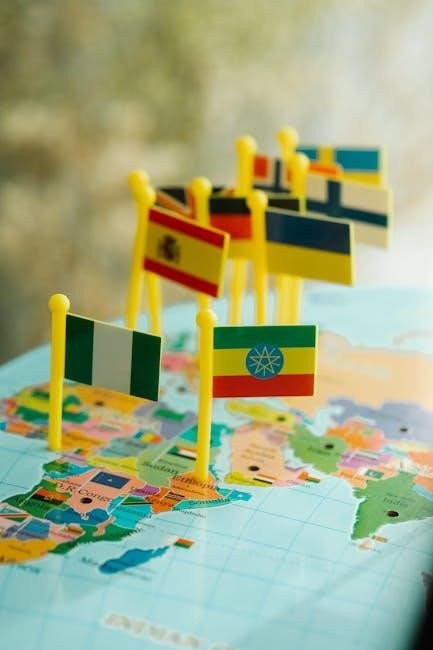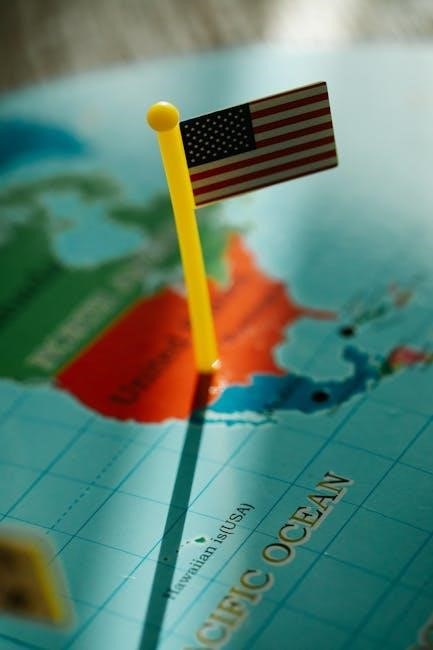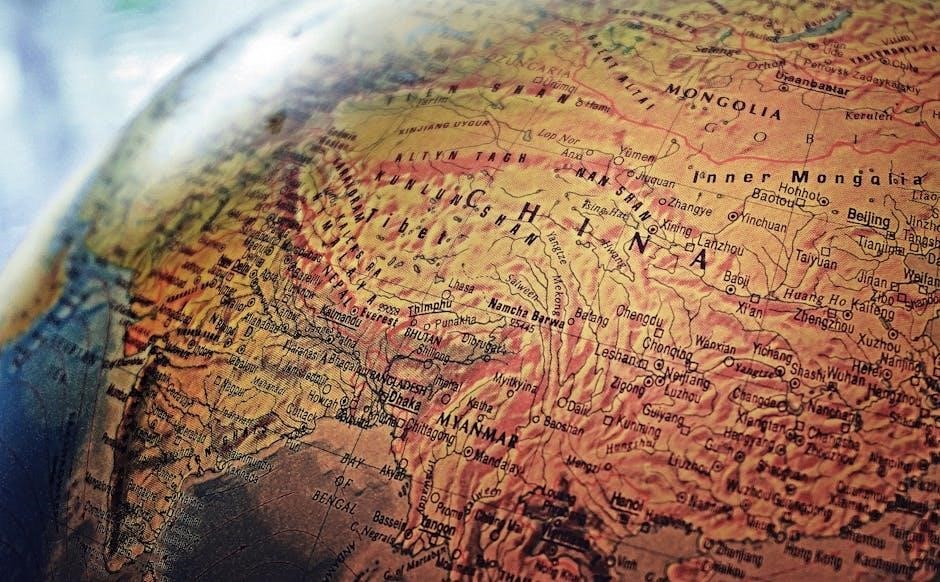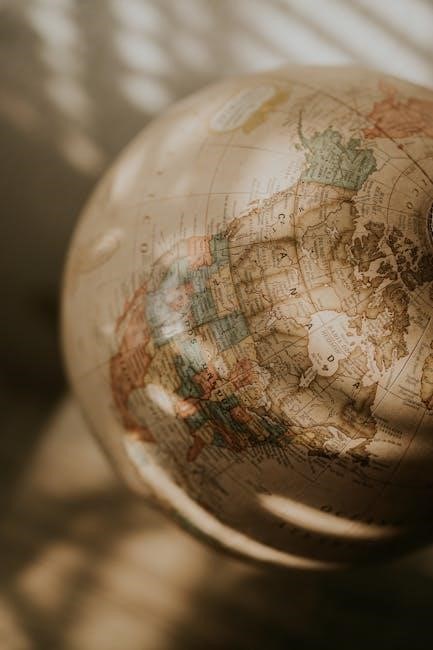AP World History Unit 4 covers 1450-1750, focusing on transoceanic interconnections, maritime empires, global trade, the Columbian Exchange, and the Atlantic Slave Trade, shaping the modern world.
1.1 Overview of the Time Period (1450-1750)
The period from 1450 to 1750 marked a transformative era in world history, characterized by the expansion of maritime empires, the Columbian Exchange, and the rise of global trade networks. This timeframe saw the emergence of European powers like Portugal and Spain, which established transoceanic connections, reshaping economies and cultures. The Atlantic Slave Trade became a central component of these systems, while joint-stock companies and mercantilist practices drove economic growth. Technological advancements, such as the carrack and fluyt ships, facilitated exploration and trade. These developments laid the foundation for global interdependence, shaping the modern world and setting the stage for future colonial and economic shifts.
1.2 Key Themes and Concepts
Key themes in AP World History Unit 4 include the impact of cross-cultural interactions, technological diffusion, and the transformation of global trade networks. The period 1450-1750 saw the rise of maritime empires, the Columbian Exchange, and the Atlantic Slave Trade, which reshaped economies and societies. Themes such as mercantilism, the expansion of European power, and the exchange of goods, ideas, and cultures are central. The unit also explores how these interactions led to demographic changes, social hierarchies, and the emergence of new labor systems. Understanding these concepts is crucial for analyzing the interconnectedness of the world during this transformative era.
1.3 Importance of Transoceanic Interconnections
Transoceanic interconnections during 1450-1750 were pivotal in shaping global systems. They facilitated cultural, technological, and economic exchanges, fostering cross-cultural interactions. The diffusion of technologies, such as maritime innovations, transformed trade and travel patterns. These connections enabled the Columbian Exchange, transferring crops, diseases, and ideas between the Americas and Afro-Eurasia. Additionally, they fueled the Atlantic Slave Trade, reshaping demographics and labor systems. Such interconnections laid the groundwork for global trade networks, mercantilism, and the rise of maritime empires. Understanding these dynamics is crucial for analyzing the long-term consequences of globalization and the interconnectedness of the modern world.

Maritime Empires and Their Impact
European maritime empires, such as Spain, Portugal, Britain, France, and the Netherlands, expanded territories, controlled trade routes, and reshaped global economies and political structures.

2.1 Rise of European Maritime Empires
European maritime empires emerged during the 15th to 18th centuries, driven by technological advancements and economic ambitions. Portugal and Spain pioneered exploration, establishing colonies in the Americas, Africa, and Asia. The Netherlands, England, and France later joined, competing for dominance in global trade. Joint-stock companies, like the Dutch East India Company, financed voyages, enabling the expansion of empires. European powers sought resources, markets, and strategic outposts, fostering global interconnections. Maritime supremacy relied on naval technology, such as the carrack and astrolabe, which facilitated oceanic travel and trade. This period marked the beginning of European global influence, reshaping economies and cultures worldwide.
2.2 Role of Technology in Maritime Expansion
Technological advancements played a pivotal role in maritime expansion during 1450-1750. The development of the carrack and fluyt ships enabled longer voyages, while the astrolabe and compass improved navigation. These innovations facilitated exploration and trade, connecting distant regions. The carrack’s multiple masts and lateen sails enhanced maneuverability, while the fluyt’s design optimized cargo capacity. Such technologies not only spurred European dominance in global trade but also fostered cultural and economic exchanges. The diffusion of these maritime technologies across regions further accelerated global interconnections, shaping the modern world economy and political landscapes.
2.3 Impact of Maritime Empires on Global Trade
Maritime empires significantly influenced global trade by establishing and controlling vast networks across oceans. European powers like Portugal, Spain, the Netherlands, and Britain dominated trade routes, linking Asia, Africa, and the Americas. The expansion of maritime trade led to the exchange of goods such as spices, textiles, and precious metals, fostering economic growth. Joint-stock companies, like the Dutch East India Company, played a crucial role in organizing and financing these endeavors. The diffusion of technologies, such as the carrack and fluyt ships, enhanced trade efficiency. These empires’ actions reshaped global commerce, creating interconnected economies and shifting wealth distribution, with lasting effects on the world economy.

Global Trade Networks
Global trade networks expanded significantly, driven by joint-stock companies and the exchange of commodities like spices, textiles, and metals, connecting Europe, Asia, Africa, and the Americas.
3.1 Expansion of Trade Routes
The period from 1450 to 1750 saw significant expansion of trade routes, driven by maritime technologies and imperial ambitions. European powers like Portugal and the Netherlands established new sea routes, connecting Europe, Asia, Africa, and the Americas. The Columbian Exchange facilitated the transfer of goods, ideas, and cultures across the Atlantic. Meanwhile, the Manila Galleons linked Asia and the Americas, while African kingdoms participated in regional and global trade networks. Joint-stock companies, such as the Dutch East India Company, played a crucial role in organizing and financing these endeavors. These developments not only enhanced economic interdependence but also reshaped global patterns of trade and cultural exchange.
3.2 Role of Joint-Stock Companies
Joint-stock companies played a pivotal role in global trade during 1450-1750. These organizations allowed investors to pool resources, spreading risk and enabling large-scale ventures. Companies like the Dutch and British East India Companies dominated maritime trade, establishing colonies and monopolizing routes. They facilitated the diffusion of technologies, such as the fluyt ship, and commodities like spices and textiles. By attracting diverse investors, joint-stock companies financed expensive voyages and hired skilled labor, driving economic growth. Their practices shaped global markets, spreading mercantilist policies and fostering European dominance in trade. This model was crucial for expanding empires and connecting distant regions economically and culturally.
3.3 Commodities and Their Significance
Commodities like sugar, tobacco, spices, and textiles played a central role in global trade networks from 1450 to 1750. These goods drove economic growth and shaped cultural exchange. Sugar, for instance, became a highly sought-after commodity, fueling plantation economies in the Americas. Tobacco emerged as a lucrative cash crop, particularly in the Atlantic region. Spices, such as pepper and cinnamon, were prized for their culinary and preservative qualities, influencing trade routes and imperial rivalries. Textiles, including silk and cotton, connected Asia, Europe, and the Americas, reflecting the interdependence of global markets. The exchange of these commodities not only enriched economies but also reshaped societies and labor systems worldwide.
The Columbian Exchange
The Columbian Exchange transferred plants, animals, and diseases between the Americas and Europe/Africa, reshaping societies, economies, and cultures, with lasting global impacts.
4.1 Biological Exchanges
The Columbian Exchange led to significant biological exchanges between the Americas and the Old World. Crops like maize, potatoes, and sweet potatoes were introduced to Europe, Africa, and Asia, boosting food production and population growth. In return, Europeans brought wheat, horses, and cattle to the Americas, transforming local agriculture and transportation. However, the exchange also introduced diseases like smallpox and influenza, devastating indigenous populations who lacked immunity. This biological exchange reshaped ecosystems, economies, and societies, creating lasting demographic and cultural changes. These interactions highlight the profound impact of transoceanic connections on global history during this period.
4.2 Cultural and Social Impacts
The Columbian Exchange led to significant cultural and social changes worldwide. European languages, religions, and traditions spread to the Americas, while indigenous cultures influenced European societies. The introduction of new crops like maize and potatoes transformed diets globally. Social structures were reshaped by the integration of enslaved Africans and the displacement of native populations. The blending of cultures created new identities and practices, while also fostering tensions and conflicts. These interactions laid the foundation for modern multicultural societies and highlighted the complexities of cross-cultural exchange. The social impacts of the Columbian Exchange remain a critical area of study in understanding global history.
4.3 Economic Consequences
The Columbian Exchange had profound economic impacts, reshaping global trade and wealth distribution. New crops like maize, potatoes, and cassava boosted food production in Europe and Asia, enabling population growth. In the Americas, European crops such as wheat and sugarcane transformed local economies. The introduction of horses and livestock revolutionized agriculture and transportation. However, the exploitation of indigenous labor and resources led to economic disruption and inequality. The flow of silver and gold from the Americas enriched European economies, financing further exploration and trade. This exchange laid the foundation for global economic systems, fostering mercantilism and shaping the modern capitalist world. The economic consequences were both transformative and unequal, influencing patterns of wealth and power for centuries.
The Atlantic Slave Trade

The Atlantic Slave Trade (1450-1750) involved the forced migration of millions of Africans to the Americas, shaping global economies, societies, and racial hierarchies profoundly.
5.1 The Triangular Trade System
The Triangular Trade System was a network of routes connecting Europe, Africa, and the Americas, driven by the exchange of goods, enslaved people, and raw materials. European powers like Britain, France, and Portugal established this system to supply their colonies with labor. Enslaved Africans were forcibly transported to the Americas, while raw materials like sugar, tobacco, and cotton were shipped to Europe. Manufactured goods, such as guns and cloth, were sent to Africa to exchange for more enslaved people. This system fueled economic growth in Europe and the Americas but had devastating demographic and social impacts on Africa and enslaved communities.
5.2 Demographic and Social Impacts
The Atlantic Slave Trade caused massive demographic shifts, with millions forcibly migrated, leading to depopulation in Africa and altered populations in the Americas. Social structures were disrupted, as enslaved people were torn from their communities, affecting family and cultural ties. The transatlantic system intensified racial hierarchies, shaping social inequalities that persisted for centuries. In the Americas, the influx of enslaved Africans transformed labor systems, while in Africa, some societies faced instability due to the loss of people. These changes deeply impacted social dynamics, cultural identities, and economic systems, leaving a lasting legacy of inequality and racial discrimination globally.

5.3 Resistance and Legacy
The Atlantic Slave Trade faced significant resistance from enslaved individuals and abolitionists. Enslaved people employed various forms of resistance, including revolts, escapes, and cultural preservation. These acts challenged the system’s legitimacy and highlighted its brutality. The legacy of the slave trade profoundly impacted global societies, shaping racial ideologies, economic systems, and cultural identities. Abolition movements emerged, influenced by Enlightenment ideas and moral critiques, leading to eventual bans on the trade. The long-term consequences include ongoing social inequalities and racial tensions, making it a critical area of study for understanding modern global dynamics and the fight for human rights.

Economic and Labor Systems
From 1450-1750, mercantilism shaped economies, while chattel slavery emerged, tying race to hereditary servitude. Global economic shifts and labor changes defined this transformative period.
6.1 Mercantilism and Its Practices
Mercantilism was a dominant economic theory in Europe during 1450-1750, emphasizing state-sponsored monopolies and government regulation to maximize exports and minimize imports. Nations like Spain, France, and England adopted mercantilist policies to accumulate wealth, often through colonial resources. Key practices included state-sponsored monopolies, tariffs, and navigation acts to control trade. Joint-stock companies, such as the Dutch East India Company, played a central role in expanding mercantilist goals. This system reinforced the idea that a nation’s power depended on its wealth, particularly in gold and silver. Mercantilism also justified colonial exploitation, shaping global economic inequalities and laying the groundwork for future capitalist systems.
6.2 Changes in Labor Systems
Between 1450 and 1750, labor systems underwent significant changes, particularly with the rise of chattel slavery, which became racialized and hereditary. This shift replaced earlier forms of indentured servitude and forced labor. European powers exploited enslaved Africans in plantations, mines, and other economic ventures, fueling global trade networks. The triangular trade system reinforced this labor structure, linking Europe, Africa, and the Americas. These changes reshaped economies, societies, and cultural identities, creating long-lasting impacts on global inequality and racial hierarchies. Understanding these labor transformations is crucial for analyzing the economic and social dynamics of the period.
6.3 Global Economic Shifts
The period from 1450 to 1750 witnessed significant global economic shifts, driven by the rise of European maritime empires and the expansion of trade networks. The accumulation of wealth in Europe, particularly through mercantilist practices, reshaped global economic power dynamics. Joint-stock companies, such as the Dutch and British East India Companies, played a pivotal role in centralizing wealth and resources. Meanwhile, the Columbian Exchange introduced new commodities, altering economic priorities worldwide. This era also saw the decline of Asian-dominated trade systems and the emergence of Europe as a global economic hub. These shifts laid the foundation for future capitalist systems and global economic interdependence.

Technological Diffusion

Technological diffusion during 1450-1750 included the spread of maritime innovations like the carrack and fluyt, enhancing trade and travel, and agricultural tools, boosting productivity globally.
7.1 Diffusion of Maritime Technologies
The diffusion of maritime technologies during 1450-1750 revolutionized global exploration and trade. The carrack, developed by Spain and Portugal, featured a combination of square and lateen sails, enhancing navigation. The fluyt, from the Netherlands, was a cargo-efficient ship that dominated trade routes. These innovations spread across Europe, enabling maritime empires to expand. The adoption of the astrolabe and compass facilitated precise navigation, while advancements in shipbuilding materials and designs improved durability and speed. Such technological exchanges not only connected distant regions but also spurred economic growth and cultural exchange, laying the foundation for global interconnections and the rise of European maritime dominance during this period.
7.2 Spread of Agricultural Technologies
The period from 1450 to 1750 saw significant advancements in agricultural technologies, driven by cross-cultural exchanges. Crops like maize, potatoes, and cassava spread globally, enhancing food production and population growth. European farmers adopted Asian techniques, such as rice cultivation, while African crops like yams and sorghum were introduced to the Americas. The diffusion of tools, such as the heavy plow and irrigation systems, improved efficiency. These changes not only increased agricultural output but also reshaped labor systems and economic structures, fostering global interdependence and societal transformations during this era.
7.3 Impact of Technological Exchange
Technological exchange during 1450-1750 revolutionized global trade and travel, fostering economic growth and cultural integration. The diffusion of maritime technologies, such as the carrack and fluyt, enhanced navigation and trade efficiency. These innovations enabled European maritime empires to expand their reach, connecting distant regions. Agricultural technologies, like new farming tools, increased productivity, supporting population growth. The exchange of ideas and tools also spurred industrial advancements, laying the groundwork for future economic shifts. This period marked the beginning of a interconnected world, where technology played a pivotal role in shaping global systems and fostering cross-cultural interactions that continue to influence modern societies.
Conclusion
Unit 4 highlights the transformative impact of global connections, cultural exchanges, and economic systems, shaping the modern world and preparing students for the AP exam.
8.1 Summary of Key Points
Unit 4 explores global connections from 1450 to 1750, emphasizing maritime empires, trade networks, and cultural exchanges. European powers established vast empires, driven by technological advancements like the carrack and fluyt. The Columbian Exchange reshaped ecosystems, while the Atlantic Slave Trade profoundly impacted societies. Mercantilism and new labor systems, including chattel slavery, defined economic structures. Technological diffusion and global trade patterns transformed the world, creating interdependent economies. These developments laid the foundation for modern global dynamics, highlighting the importance of cross-cultural interactions and their enduring legacies. Understanding these themes is crucial for analyzing the AP exam’s focus on historical causation and global processes.
8.2 Long-Term Consequences
The period from 1450 to 1750 had profound and lasting impacts on global history. The establishment of maritime empires and transoceanic trade networks reshaped economic systems, fostering mercantilism and the rise of European dominance. The Columbian Exchange led to biological and cultural transformations, altering diets, societies, and environments worldwide. The Atlantic Slave Trade created enduring social and racial hierarchies, leaving legacies of inequality. Technological advancements, such as maritime and agricultural innovations, spurred further globalization. These developments laid the foundation for modern capitalism, imperialism, and global power dynamics, shaping the world as we know it today.

8.3 Preparation for the AP Exam
Effective preparation for the AP World History exam requires a deep understanding of Unit 4 concepts, such as transoceanic interconnections, maritime empires, and the Columbian Exchange. Utilize study guides and practice quizzes to reinforce key themes like mercantilism, the Atlantic Slave Trade, and technological diffusion. Focus on developing strong context statements, as they can significantly impact your score. Review primary sources and case studies to enhance analytical skills. Leverage resources like the HEIMLER REVIEW GUIDE and flashcards to master essential terms and events. Practice essay prompts and DBQs to improve writing proficiency. Regularly assess your understanding of cross-cultural interactions and global processes to ensure readiness for the exam.